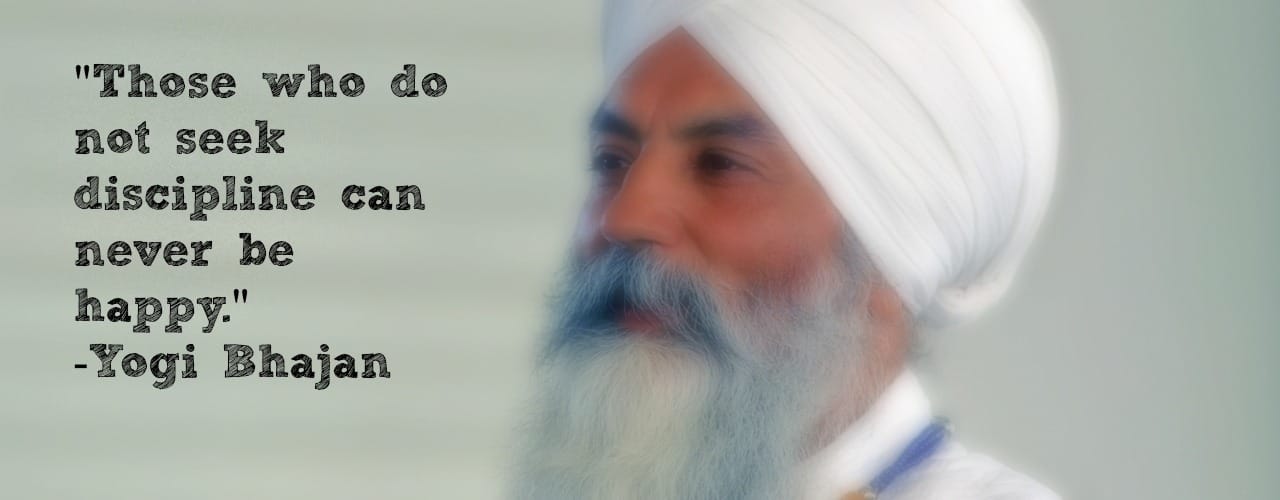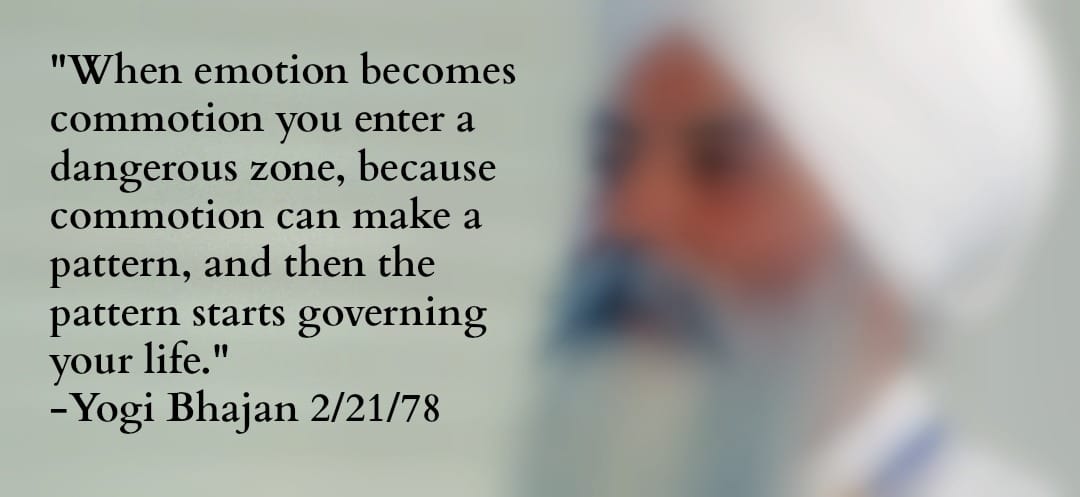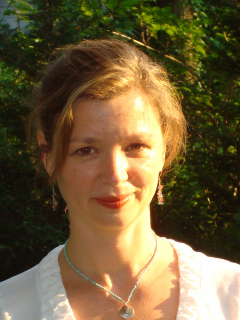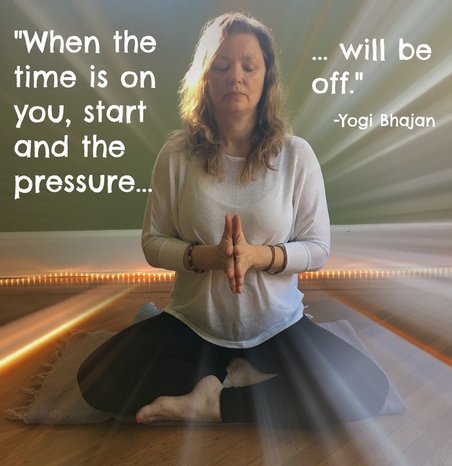 I LOVE snow days! I LOVE the kids' glee at hearing the news. I LOVE not rushing them out the door to school in the morning. I LOVE wearing pajamas all day. I LOVE soup. I EXTRA-LOVED yesterday's snow day and was extra grateful for it. It opened up some time and space for something very important to me. Let me explain. Last Saturday morning, I was racing around -- very UNmindfully -- trying to get things done. There was a full day ahead of me: my son's wrestling tournament and then a family dinner in the city. I dropped my son off at the high school for him to catch his team bus and drove home. As I drove, I ran through my list in my head -- unload the dishwasher, deflate the air mattress, make sandwiches for the tournament, etc. I arrived home. I was still in my heady to-dos and not at all in the present moment. I saw some trash on my lawn. I bent down to pick it up, thinking, "This is just what I need. More to deal with. Why am I the only one who notices these things?" I stood up and... Conk!!!!!! I'd stood up fast and hard into the metal corner of my neighbor's garage, and it'd knocked me off my feet. Long story short, I am fine. There was a surprising amount of blood. There were tears, a lot of ice and eventually an ER visit which cleared me of all things serious and concerning. No stitches required. I feel very grateful that I wasn't more hurt. I also feel grateful that I'm oriented to see it as a lesson. The first most obvious lesson is that I need to be mindful and present. I can't rush around in stress. It's actually dangerous to do so. Please don't make the mistake I made. Know where you are and do what you're doing. But also, I've been due for a reset for some time now. I've been feeling the pressure to up the ante on my personal practice -- practice more and do it more diligently. But I've been making the excuse that life is too full. Yogi Bhajan says, "When the time is on you, start and the pressure will be off." I know this quote. I've known it for sometime. If only knowing quotes from the masters was all that was required to make real change. If that were the case, I'd be a lot further along on my path to self-actualization. I felt the time was on me and yet, I put it off. I didn't start. So, I got myself a conk on the head. I got the message. I also got a snow day and all the cancellations that came with it, making room for the new diligence. Thank you, Universe. And to you, Reader, PLEASE START. Whatever you know you need to do... start and the pressure will be off. May the Truth in you guide you... to start. 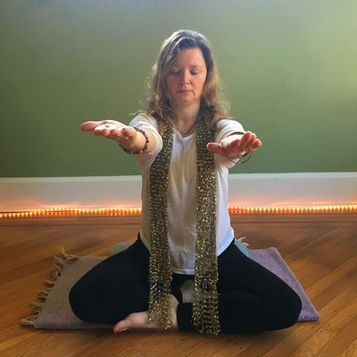 Meditation terrifies some people. They think they won't be able to do it "correctly" because they can't stop their inner dialogue in its tracks. Given that, they imagine that meditating will be just sitting with their thoughts. The idea of being bombarded by mental chatter without the distractions that modern life usually provides -- social media feeds, work, emails, household to dos, etc. -- seems like torture. These are misconceptions. And I'm on a mission to disabuse folks of these misconceptions. First of all, you don't have to stop your inner dialogue in order to meditate "correctly" or get the benefits of meditating or enjoy meditating. I have been practicing Kundalini Yoga for about 20 years and meditating a lot for nine of those years, and I have yet to experience a cessation of thoughts. Even so, I LOVE meditation, and it has been my rock. Second, if you choose a Kundalini Meditation, you are not just sitting with your thoughts. You have tools to distance yourself from the monkey mind. Most Kundalini Meditations offer a position of the arms or hands to maintain. Then, there's a specific breath practice. Frequently, there's also a designated eye focus to manage. And finally, there's usually either a chanted or silent, internal mantra attached. Each of these tools serves to bring you out of the stress of the everyday mind and into a more neutral, blissful state. Let me unpack a Kundalini Meditation to show you what I mean. Take Meditation for Tuning Up the Frontal Lobe of the Brain for example. And let's use Michael A. Singer's term the "neurotic inner roommate" to personify and understand the mind's fluctuations. Before I begin my meditation, my neurotic roomie is front and center chattering away, talking to me about all the other things I should be doing instead of sitting and meditating. I get into the position. I raise my arms to shoulder height and turn the left palm down and the right palm up (as shown above.) I know I'm supposed to hold this for 11 minutes. "Hmmmm," says Roomie. "How are you going to do that? Eleven minutes is a long time. That's going to get difficult. I don't like difficult." I begin the prescribed breath of fire. Breath of fire itself takes some attention to maintain, and it starts to get a little crowded for Roomie, who's still fairly determined to be heard ("You really should have finished the kids' laundry. What kind of mother are you anyway?"). There's no eye focus indicated for this meditation, but I use the third-eye dristi -- beneath the closed lids, I direct the eyes up and in (as if trying to see through the center of my forehead). This is my favorite focus. The sixth chakra, the center of intuition, is located here at the brow point. Directing the focus toward this intuitive space is pushing Roomie back even further until it's hanging onto the door jam -- clinging for dear life: "Listen to me!!!!!! Everything's a mess!!!!!!! So much to deal with!!!!!!!!." So, I bring in the big guns... Mantra. When I practice breath of fire, I like to use the mantra Wahe Guru. It seems to fit well with the speed of breath of fire. Wahe Guru means "a great celebration of the energy which moves me from darkness to light." Silently and internally, I match Wahe Guru to the breath. Wahe Guru. Wahe Guru. Wahe Guru. Wahe Guru. Wahe Guru. Wahe Guru. Wahe Guru. Wahe Guru. Wahe Guru. Wahe Guru. Now, the Neurotic Inner Roommate is starting to get the picture. It releases its grip on the door jam and retreats to the background, into a back corner mumbling -- still lobing thoughts at me but they are muted and distant and without force. My thoughts don't stop, but I change my relationship to them. My roomie doesn't move out, but my Higher Self is taking up more space. I'm focused on Wahe Guru, a positive, ancient sound which affects my consciousness. I'm elevating with breath of fire. I'm creating a picture of myself keeping up, keeping my arms up even when the going gets tough. Roomie might emerge from its corner at points along the way, and I'll have to refocus my eyes, intensify the breath of fire, or remember Wahe Guru. And, of course, in this position, my shoulders will fatigue, and I'll have to talk Roomie out of putting them down. The point is it's a non-linear process that, in my experience at least, doesn't feel like pure serenity. So, please forget about the goal of thoughtlessness. In the Kundalini world, we accept that the mind will be fast with thoughts, and we provide tools for not letting them take over. The tools don't stop the thoughts. Instead they take away their power to injure and their power to divert you from your sacred moment.  "Let's get pedicures!" my daughter said. My first thoughts were all the reasons why not: I have too much to do. It's too expensive. It's winter, and we can't wear flip flops. Pedicures are frivolous and unnecessary. Then, I internally argued the reasons why it was a good idea. I believe in following my children's whims sometimes. One of the best ways to connect with them is to go with their flow. (This used to mean playing pretend games, especially what we called the Irrational Baby Game, in which I acted like a tantruming infant while my children acted as adults trying calm me down. They loved that one.) What chore or email was really so important that I couldn't stop and step away to be in the moment with my girl? I weighed both sides. Everything on both sides was true, but what was the higher good? It's clear from my photo what I decided, and it was a happy choice that I think about every time I look down at my blue toes. (Guess who chose my color?) This little moment of decision-making illustrates one of Yogi Bhajan's most relatable teachings: He said that we have three functional minds: the Negative Mind, the Positive Mind, and the Neutral Mind. The Negative Mind is NO! DON'T! It protects us from danger and helps us sustain life: It says: don't touch the hot stove; refrain from jumping out of a moving car; hold off scaling the scary rock face without a belay; look both ways before crossing the street. The Negative Mind plays an important role, and is not bad by nature. Yogi Bhajan said that the Negative Mind is the first to pipe up in any decision because it's imperative (to keep you safe) is the most pressing. So it looks for danger. Nothing wrong with that. The problems arise when we get stuck there. The Negative Mind is the aspect of me that initially said no to a pedicure -- too costly, too indulgent, too time-consuming. Another example... if someone is deciding whether or not accept an invitation to give a speech, the Negative Mind might say, "NO. You could mess up, humiliate yourself, ruin your reputation, lose your job, not have enough money, not be able to eat, and then die." Unchecked, the Negative Mind would keep us under the covers. So, the Positive Mind needs to interject: YES! It could be a great experience, a learning experience, a chance for advancement and abundance. It was my Positive Mind that chimed in to tell me why spontaneous pedicures are great. My Positive Mind wanted me to preview the smile on my daughter's face when I said yes. Now, the Neutral Mind. The Neutral Mind is the aspect of ourselves that can look at the pros and cons and make a decision, an unreactive decision, from a place of Truth. The Neutral Mind knows that a speech rarely leads to death and that the opportunity far outweighs the risk because even failure could lead to good things. My Neutral Mind reminded me of my Truth: time with my daughter on her terms was more important than the money or the chores. (If this happened once a week, by the way, my Negative Mind might have some better points about expense and time.) Yogi Bhajan said that the ability to act from the Neutral Mind was one of the keys to winning the "game of life." Here's more of what he said: “To win the game of life you must have caliber. To have caliber you must have an Applied Mind. An Applied Mind is a mind that processes everything positive and negative, then acts from the Neutral Mind to express you. The Applied Mind uses the Neutral Mind to assess all positive and negative but does not react on that basis." - Yogi Bhajan We want for our decisions to be reflections of our Truth -- our uncluttered, unclouded, uncovered Sat Nam. If you've ever made decisions that are inauthentic (as I have), then you know why it matters.
Why is yoga relevant in thinking about decision making? Well, doing Kundalini Yoga and bringining the focus back again and again to Sat Nam is practice for making authentic choices in life. And holding our arms up and moving beyond pain is practice for accessing the Neutral Mind. First, we listen to the Negative Mind say, "There's no way I can keep going. My heart's beating too fast. I'm scared. My arms hurt too much. I can't do it." Then, we hear the Positive Mind say, "You can do it. You're strong. You can go for a long, long time, longer than anyone else." And then, we weigh and hopefully we choose to keep the arms up, not to prove anything, not to compete, but to dwell in Truth. Let's keep up together in neutrality. It'll make our lives better. May the Truth in you guide you. Sat Nam. 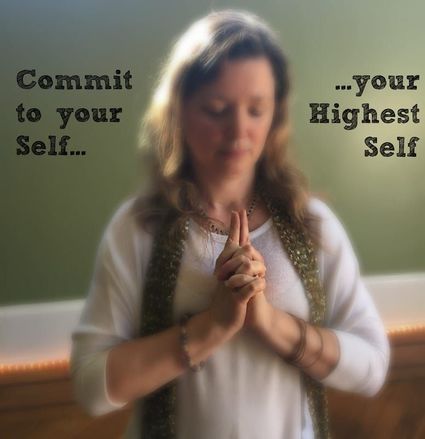 I've been thinking about my New Year's Resolution and trying to craft the perfect one. I know what I want, but I also believe that it matters how I express it to myself in my head. The words that carry my intention matter. Here's the big picture of what I'm going for: I want my whole life to be my practice. I want to be present, true, and kind as often as possible. I want to make nourishing, healing choices for my body and mind as often as possible. A tall order... Too tall? There's a school of thought that one should break down one's goals into practical steps, in which case I'd phrase my resolution like this: I resolve to look at my phone less and listen openly to my children more; to speak my Truth, rather than say what people want to hear; to eat fewer salty snacks and sweet treats, and drink more green juice; to watch less TV and listen to more mantra. Maybe. That might work. But already I'm thinking about the stuff I left out, like making the laundry a mindfulness practice and cooking more. I find it tough to get the language just right. If creating a resolution is tricky, then keeping one is even trickier. Most resolutions don't stick. I've dropped quite a few resolutions myself over the years. Even though we work on resolve in Kundalini Yoga (when we work on the navel center, center of discipline and commitment), it can still be difficult to stay the course. Even though we stress keeping up in Kundalini Yoga (and we practice keeping up by literally holding our arms up in the air for surprising lengths of time), we can still give up on our resolutions. Even though we work on our egos in Kundalini Yoga, we can still succumb to that voice in our heads and let it drown out the intentions of our Higher Selves. Our resolutions must reflect our True Selves, our Higher Selves, and then we must commit. How? How can we compose just the right resolution? And how can we stick to it beyond the initial burst of enthusiasm the first week of January? I want to know. So, I asked my teacher, Dharma Devi, to create a workshop around the topic of New Year's Resolutions for us. I am happy to say that she said yes, and we will have her guidance and inspiration on how we can shape our futures and stay true to what we promise ourselves. I hope you'll join us on Sunday, January 8 from 2-5pm for Shakti Dance™, The Yoga of Dance: Shed Internal Barriers and Manifest Your Intentions. Click here for more information and to sign up right now. 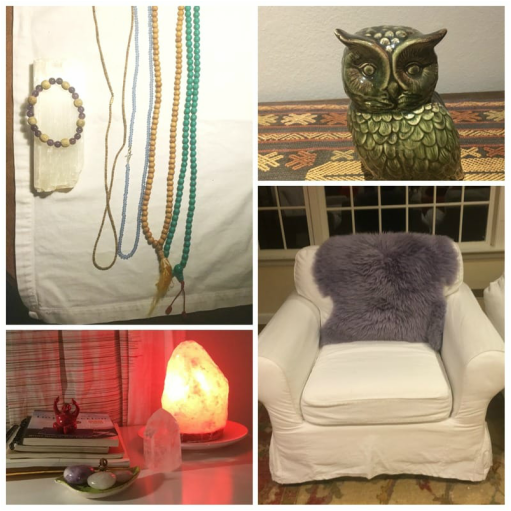 The items I keep around my house to remind me of my practice. The items I keep around my house to remind me of my practice. I had an argument with my husband, Evan, the other night. We were out, and I wanted to head home on the early side to make sure the kids were done with homework and on their way to bed at a reasonable hour. He wanted to stay out later. Evan prevailed. We stayed out later, and all the consequences that I'd predicted unfolded. Homework went really late, and bedtime was really, really late. That meant that nobody wanted to wake up the next morning, and everything was a big, messy rush. My daughter didn't eat her breakfast. My son forgot his lunch and his gym bag. I'm not proud of this, but as I dealt with the "fallout," I got stuck in an inner monologue about how right I'd been and how wrong Evan had been. I allowed my agitation to distract me, and I made some mistakes, forgot some important things, and ran late. I rushed to get to work. I barely made it to the yoga studio in time to let the first student in. And when I did arrive, I realized that I didn't have my computer which has my music. That's okay, I told myself, I can use my phone. I looked at my phone, and it only had 7% charge. I was in a stressful state. I was consumed with my "victimhood." Everything was my husband's fault. Negativity swirled and spiraled within me. It sounds melodramatic. But this is how stress is for most of us. Little things feel big. Stress distorts and amplifies minor inconveniences. I started to set up for class. I rolled out a mat. And suddenly, I began to shift. The rolling out of the yoga mat created a kind of Pavlovian response in me. The sound of it thwacking against the floor signaled my brain and my heart: you're going to get some relief now. And I did. I began to return to balance and perspective. I could see (what all of you reading this can already see) that the events of my morning were no big deal. As the stress dissolved, I began to see through the lens of hindsight. Maybe it was nice that Evan wanted to extend our date. Maybe I was being uptight. Maybe. Yoga and even just the anticipation of yoga brings me back to the here and now. When I'm pulled away from the present moment into a drama of the mind, that's when I stub my toe, lose my keys, drop the water bottle, drive to the wrong place, forget to charge my phone, etc. That's when I feel out of control. That's when I forget that I have the tools to access tranquility. If we want to avoid the mistakes and mishaps and -- most importantly -- the nauseating twist of sour rumination, we have to choose presence again and again. Not just on the mat. I have little reminders around my house of my practice -- my malas on my nightstand, my sheepskin draped over a chair, beautiful crystals on my desk, a ceramic owl on the entryway table (all pictured above). That owl is very special because it symbolizes that even in the darkest of times I can see the way. If I catch a glimpse of my reminders when I'm tense, they can give me the same experience that the thwack of the mat gives me: my shoulders relax, my jaw softens, my breath slows down, and I can remember that I have the capacity for peace and shift into that peace pretty quickly -- if I choose to. I have to choose to, that's the key. These items were around the same messy morning that I was dwelling in the past and creating stress, but I didn't focus on them; I didn't use them. I just stormed and stomped by them. Next time, I hope to do better. What reminds you of your practice? Could you put it some place where you need to see it, some place where you could really use a nudge toward serenity? Your car? Your kitchen? Your office? May the Truth in you guide you. Sat Nam. 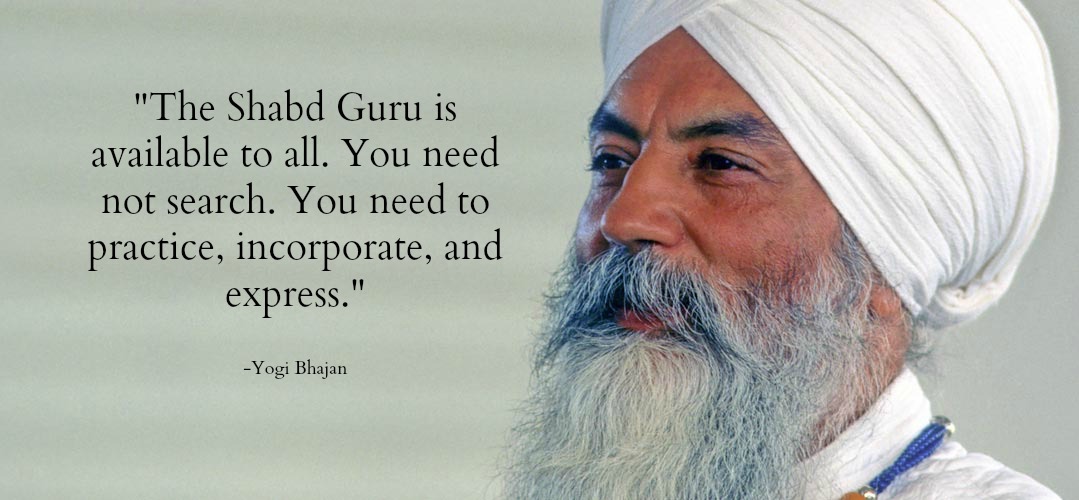 Those of you who've come to my classes know that I LOVE chanting. I LOVE chanting loudly, and I don't care if I'm off key. I LOVE how I feel when I chant -- transported out of my everyday mind and lifted out of the fog. I LOVE offering the technique of singing sacred sounds to my students because I see on your faces how it moves you into a different state of mind and being. Well lately, I've been learning about something that is said to be even more powerful than the mantras we chant in class. Within the Kundalini Yoga tradition and given to us by Yogi Bhajan, there are longer mantras called Shabds. When these Shabds, or sacred prayers, are recited, the sound itself becomes the teacher, the Guru, that which brings us from darkness to light. This is why when these longer mantras are discussed, they're often referred to as Shabd Guru. I've been reading up on the benefits of Shabd Guru, and what I've discovered is VERY COMPELLING. Everything I've found suggests that these prayers have profound healing benefits. This reminds me of what one of my teachers always says about food to help her students remember to only take in what is nourishing: "Drink your medicine. Eat your medicine." In the case of the Shabd Guru, we sing our medicine. Here's a taste of what I've learned about Shabd Guru so far: From the article What is Shabd Guru? "Affirmations and positive statements are helpful and good to use. Mantras are effective and gradually create changes. But the Shabad Guru is unique. The patterns are a perfect weave of rhythm, sound, tone, focus, and meaning. There is nothing as effective and universal as those patterns to program the consciousness to be in alignment with the soul." From the article Benefits of Shabd Guru "When we sing, chant or recite the Shabad Guru in a relaxed and mindful manner, we become aware of our full range of feelings, our inner stories, our concepts and the voice of our higher self our intuition... the Shabad reorganizes all of that mental and emotional energy into an Infinite pattern. We start to see ourselves and our lives in the context of a timeless, Divine play." From the article Shabd Guru "The Shabad Guru is a special kind of technology. In the body it produces vitality; in the complex of the mind it awakens intelligence and develops wisdom and intuition; in the heart it establishes compassion; in each person’s consciousness it builds the clarity to act with fearless integrity." There's also an article called A Quantam Technology of Sound that I found impossible to excerpt, but is definitely worth a read. Beautiful description of how sound affects the different systems of the body. Two examples of Shabds... The only one I've experienced to date is So Purkh, which is a Shabd that women chant for the men in their lives. I had kind of a knee jerk reaction to that the first time I heard about it. Why are we chanting for men? Why aren't we chanting for ourselves? It felt unfeminist somehow. But then, I realized that whenever we chant we elevate ourselves, of course. And I heard stories of true shifts that emerged during 40 day dedications to So Purkh. You can read about So Purkh more here.  This Sunday, in a workshop we're hosting, I'll learn the Shabd Bhand Jammee-ai, which is chanted to uplift women and is said to free us of insecurities. Yogi Bhajan taught that every woman should know Bhand Jammee-ai. If it resonates with me, I may embark on a 40 day practice of chanting Bhand Jammee-ai. This is a sample of one beautiful musical version of the prayer by Gurunam. Sound as guru entices me. I LOVE that chanting and healing from chanting is easy. We don't have to hold our arms up for an hour or work our navel centers to exhaustion to experience change. That work is important too, but with chanting we learn some new words and sing. What a joy to heal so easily! The hard part is the 40 day commitment, because our minds want to derail steadiness. That's where the challenge lies. The vastness of the teachings of Kundalini Yoga and the healing they provide never cease to amaze me. I continue to be grateful that I happened upon a Kundalini Yoga class almost 20 years ago and fell in love. 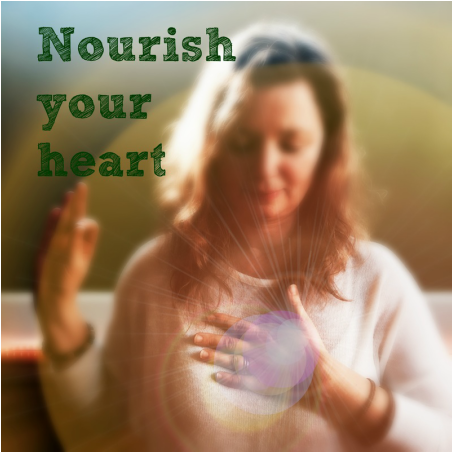 My mother suffers from Alzheimer's disease, and my whole family feels the tragedy of that all the time. She had more to do, not the least of which was doting on and getting to know her grandchildren. I know many of you out there know this same pain. The miracle within the tragedy is that she is happy -- smiling, laughing, hugging. That is a blessing because it could be otherwise. She doesn't speak coherently anymore, except for a few words here and there that we know are meaningful, "Baby," "Love," "Thank you." We are so grateful for each of these glimpses into her reality. I feel strongly that she still knows who I am, but it has been awhile since she's said my name. Her mind is mostly a mystery to us. Over Thanksgiving, I enjoyed simple time with her, just holding her hand. We didn't exchange anything of the mind, but we communicated heart to heart. I felt it. Her heart is as it always was -- open, compassionate, and even ecstatic. As I watch my mother continue to exude joy despite her declining brain function, I'm reminded of one of the most important lessons of yoga: the Self is not just a mind. Our identities are not just a collection of ideas, memories, and beliefs. That sense of self is in fact what we endeavor to deconstruct and dissolve when we're on the mat. Who we are is so much more than just a body and a brain. As yogis we work on it all -- mind, body, spirit, heart. Heart. The heart center. The heart chakra -- an invisible concentration of energy that can flow freely within and radiate love or can be clogged, shut down, and dim in its projection. I believe that, for some, open-heartedness comes naturally. My mother is one of these people. She doesn't need to think about radiating love, happiness, and generosity of spirit; she just does. She doesn't need to meditate and direct prana to her heart center. Her heart is engaged and enlivened without effort. Others of us need to actively nourish our hearts. But how? One of the most "nutrient dense" practices I know is Meditation for a Calm Heart. This is perhaps the meditation I talk (even proselytize) about the most. With consistent practice, it soothes even the stormiest of hearts. Try it -- every day for 40 days to get the full effect.
May we all nourish our hearts, so that -- come what may -- we can offer smiles and hugs. Sat Nam. 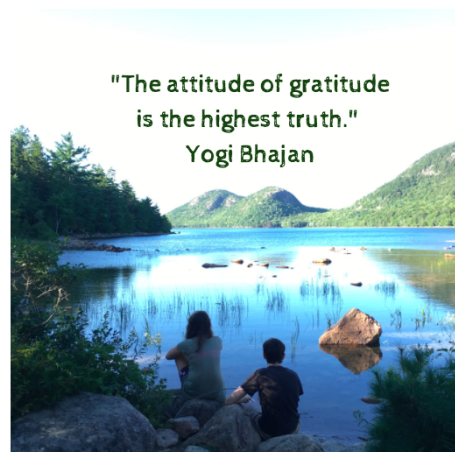 This image is my kids sitting on some rocks in Acadia National Park this past summer. It was after a screen-free day -- hiking, trying to find the perfect walking sticks, having contests for who could balance on a bumpy rock wall the longest without falling, and skipping stones. Simple pleasures. Seeing them sit by the water together doing nothing but look and breathe fresh air made me feel happy and grateful. It was a special moment. But can I feel grateful all the time? Yogi Bhajan said, "The attitude of gratitude is the highest truth." I think he said that it's the highest because it can be the hardest. It's not automatic to shift into gratitude and count your blessings when you're overwhelmed by negativity. Although it's not in our best interest, we can feel drawn into the darkness. Darkness can be enticing in its way. But we can try to shift. We can wake up every morning with gratitude for a new day. We can list the gifts in our lives every night before we go to sleep. We can have an intention of gratitude, if not a consistent attitude of gratitude. 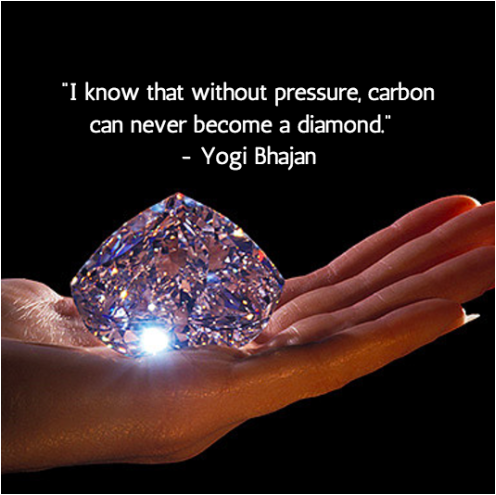 Some people have the idea that Kundalini Yoga is easy. This is true in one sense and very untrue in another. It's true because we are most often sitting in easy pose and not jumping into chaturanga or kicking into handstand. It's not true because we have many extremely pressurized exercises -- holding our arms up for 11 minutes or more, for example. These exercises are part of the reason Kundalini Yoga works for me. Granted, I'm not excited when I'm the student and one of these comes up. I go through a whole mental process in those 11 minutes. It can start with discouragement (sometimes internal cursing). Then I shift into a silent pep talk - "I know can do it. I've done it before. I'll be so happy I kept up. Be honest. Not lazy." That mental state morphs into a determined commitment, and every once in awhile, commitment transforms into a euphoric feeling that I could stay in it forever. It's become clear to me that I need to go through that process, so that I can experience my strength and remember that I am strong -- that I can conquer my mind. Some of us need the intensity of this practice in order to be fully present for a spiritual experience. Yogi Bhajan's words tell us the greater purpose of these powerful exercises: "I know that without pressure, carbon can never become a diamond. If you think you cannot stand the pressure, then you do not know ... you are a human being, because the human body... (has) been made to withstand extreme pressure to crystallize the consciousness." To crystallize the consciousness. To reach our highest. To experience that part of us that is beyond the thinking mind. |
Blog by Cate BailyCate discovered Kundalini Yoga by accident over 20 years ago and was surprised and thrilled by how engaged, energized, and inspired it made her feel. She's been practicing ever since. Click here for more complete bio.
Categories
All
|
Location127 Valley Road
Montclair, NJ |
|

